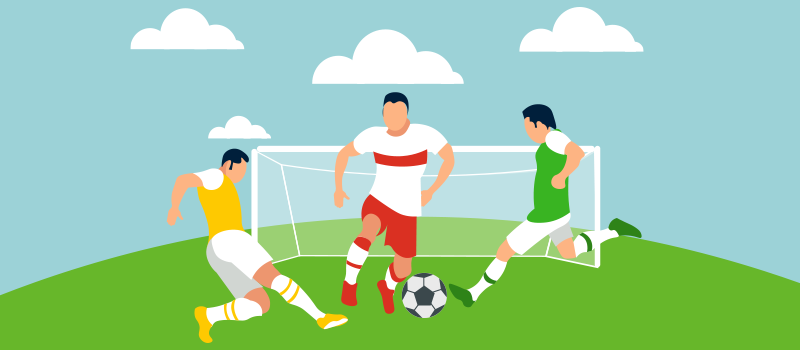What’s the Buzz
The Bee Healthy Blog
Tinactin for Athlete’s Foot: How Does It Work?

-
Athlete’s foot (tinea pedis) is a common fungal infection in people who wear ill-fitting shoes.
-
Symptoms include red, flaky, itchy skin on the feet and between the toes. It is contagious, and proper care and caution should be used when you have athlete’s foot.
-
Tinactin is an antifungal medication used in treating athlete’s foot as it prevents fungal growth. Most people see relief within 2 to 3 days of using Tinactin daily.
Athlete’s foot (tinea pedis) is a fungal infection common in people who wear tight-fitting shoes that lack proper ventilation, leading to sweaty feet. Athlete’s foot typically starts showing symptoms in between the toes. Signs and symptoms include a scaly, peeling rash and itchy skin between the toes and on the bottom that spreads to the sides of the feet. Other signs include cracked, inflamed, blistering, and burning skin.
Athlete’s foot is contagious and commonly contracted through contaminated towels and clothing and by walking barefoot in public areas such as locker rooms and shower areas.
Tinactin is an FDA-approved antifungal medication that can help in treating and preventing athlete’s foot. It is also used to treat ringworm (tinea corporis) and jock itch (tinea cruris). You can purchase Tinactin over-the-counter without a prescription. Please continue reading to find out more.
What is Tinactin athlete’s foot cream? How does it work?
Tinactin is a brand name product. It contains the generic medication tolnaftate as the active fungus treatment ingredient. Inactive ingredients in Tinactin include cetostearyl alcohol, ceteth-20, chlorocresol, propylene glycol, mineral oil, sodium phosphate monobasic, white petrolatum, and purified water.
Tinactin is an antifungal drug that prevents fungus growth. It comes in various types of topical formulations, such as cream, gel, ointment, lotion, liquid, powder, and aerosol spray for application to the affected skin. You can easily rub or spray the product directly onto your feet.
Does Tinactin work on athlete's foot fungus?
Yes, Tinactin is proven clinically effective on athlete’s foot fungus. It is a fungicide that kills the fungus and relieves uncomfortable burning, itching, soreness, and redness. This medication can be used to treat and prevent athlete’s foot.
How to use Tinactin?
Clean the affected area and allow it to dry. Apply a thin layer of Tinactin cream or gel twice a day. Rub in the medicine until most of it disappears. Wash your hands afterward. Use the spray and powder forms between the toes. Shake the spray well and use it from about 6 inches away. You can also spray your shoes and socks lightly. You may need to try different products and formulations to find the one that works for you.
How quickly does Tinactin help with athlete’s foot symptoms?
Most athlete’s foot symptoms start to improve within 2 to 3 days of using Tinactin daily. However, you should continue treatment even after your symptoms have improved to ensure a complete cure. The recommended duration of therapy to treat infections such as athlete’s foot or ringworm is typically one month of using this medication as directed, and the duration of treatment for jock itch is about 2 weeks. If the symptoms come back, you might need to start applying Tinactin again. Call your doctor if you do not get any relief from your athlete’s foot symptoms after 2 weeks of regular Tinactin use.
What are the side effects of Tinactin?
Tinactin is generally well tolerated. However, it may cause skin irritation. Stop using the medicine and contact your doctor if the application site irritation persists or gets worse over time.
Avoid scratching the athlete’s foot rash. You may find that soaking itchy feet in cool water provides relief from uncomfortable symptoms.
Who should not use Tinactin?
Tinactin should not be used in children under 2 years of age without a doctor’s supervision. Do not use Tinactin if you have had an allergic reaction to this medicine in the past.
What is the strongest treatment for athlete's foot?
Most athlete's foot responds to nonprescription products such as Tinactin and self-care measures. However, more severe infections may need to be treated with other drugs, such as prescription-strength antifungal creams or ointments, for example, econazole (Ecoza), clotrimazole (Lotrimin AF), or ciclopirox (Loprox). A serious infection might require an oral antifungal in pill form, such as terbinafine (Lamisil AT) or itraconazole (Sporanox, Tolsura). Your doctor may also prescribe a combination of topical and oral medicines.
Why is Tinactin being recalled?
The pharmaceutical company Bayer voluntarily recalled certain Tinactin and Lotrimin AF spray products distributed between September 2018 and September 2021 due to the presence of benzene, a cancer-causing substance, in some samples. This was done as a precautionary measure even though there were no expected adverse health consequences anticipated.
How to prevent athlete’s foot?
The fungi that cause athlete’s foot thrive in warm environments where there is moisture. You can lower your risk of contracting athlete’s foot with the following measures:
-
Keep your feet dry and clean. Wash your feet twice a day and make sure you dry between the toes.
-
Wear well-ventilated footwear to reduce perspiration. Avoid shoes made of rubber, vinyl, or other synthetic materials. Wear sandals whenever possible.
-
Change your socks at least once a day and more often if you are prone to sweating a lot.
-
Change shoes and alternate between pairs. Allow your shoes to dry for at least 24 hours before using them again.
-
Avoid walking barefoot in public places such as public pools, shower areas, and locker rooms. Wear flip-flops or waterproof sandals.
-
Don't wear someone else’s shoes as this increases the risk of athlete’s foot spreading.
-
Use athlete’s foot products such as Tinactin, which treats and helps prevent fungal infections.
References:

SOCIAL